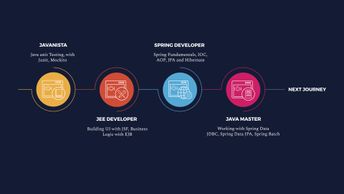Aspire Javanista to Java Master Javanista to Java Master Track 3: Spring Basics
Final Exam: Spring Basics will test your knowledge and application of the topics presented throughout the Spring Basics track of the Aspire Javanista to Java Master Journey.
| Objectives |
Final Exam: Spring Basics - apply autowiring to the beans created from a class using the Autowired annotation
- apply Hibernate APIs to persist the data in Java objects to a relational database
- apply the Autowired annotation to the setters and constructors of a bean class
- configure a pointcut using the within designator in order to map to join points within a class or package
- configure entities in an application using JPA annotations
- create a class whose beans depend on several other beans
- create a custom annotation in order to explicitly define the methods that must match a pointcut
- create an ApplicationContext instance to provision and inject beans
- create a project where aspects can be configured with an XML file
- define a class whose members will serve as the composite key for an entity in an application
- define a method that can be set as an aspect in a Java application
- define entities in an application that have a one-to-one relationship with one another
- define pointcuts in your application that apply to methods in multiple classes
- describe Spring framework and recognize how it can help Java developers
- describe the features available in the Spring framework to implement dependency injection
- execute aspects after a method has executed successfully or when it throws an exception
- implement a one-to-many relationship between entities in an application using JPA
- outline the limitations of autowiring
- outline the model-view-controller design paradigm and how Spring can help implement it for an application
- recognize different ways to define pointcuts
- recognize how Spring Boot can be used to simplify application development
- recognize the concept of dependency injection and inversion of control
- recognize the different ways in which bean references can be set
- recognize what mechanisms are available to implement aspect-oriented programming in Java
- set aspects to run before and after certain methods in your application using before and after advices
- set methods to run after bean construction and before their destruction
- set the properties of a bean using tags in an XML file
- use Apache Maven to create a Java project that uses the Hibernate framework
- use JPA configurations and annotations to define the entities in a Java app and map them to a relational database
- use the JPA APIs to add new data to and retrieve existing data from a table in a relational database
|


